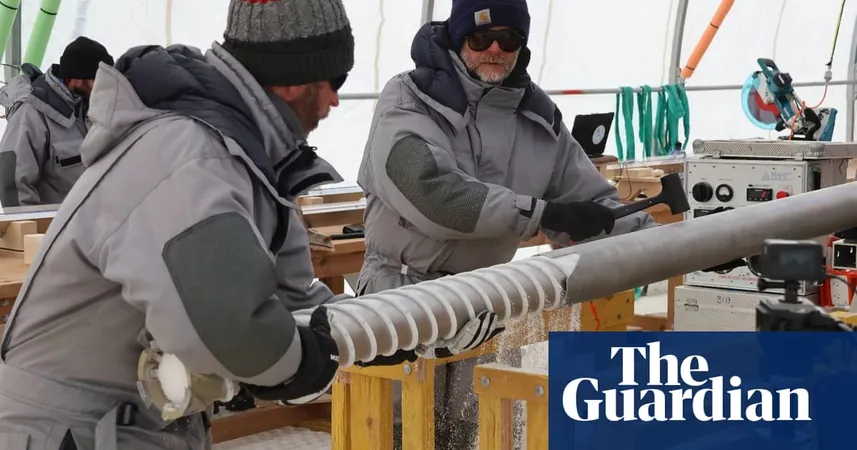
Australians on a High-Stakes Mission to Uncover the Secrets of Earth's Oldest Ice
2025-01-19
Author: Nur
Groundbreaking Expedition in Antarctica
In the forbidding realms of Antarctica, where extreme weather and unyielding conditions have historically thwarted human endeavors, a team of dedicated Australian scientists has embarked on a groundbreaking expedition—a quest to uncover the world's oldest ice and the secrets it may reveal about our planet's climatic history.
Leading the Charge
Leading this endeavor is Dr. Joel Pedro, a paleoclimate scientist spearheading Australia's Million Year Ice Core project. As temperatures descend to a bone-chilling -30°C on the Antarctic plateau, Dr. Pedro remains determined to achieve a monumental breakthrough: excavating ice that has been trapped for over a million years. This ancient ice, locked away in bubbles, holds vital clues about Earth's past climate, essential for understanding how current escalating CO2 levels are shaping our future.
Challenges Faced
The road to discovery, however, has not been easy. The previous Antarctic season brought a series of challenges, including a 1,200-kilometer logistical struggle that involved transporting heavy equipment across unforgiving terrain. Compounding their difficulties, a COVID outbreak struck the team at Casey Research Station, forcing the evacuation of several members and delaying critical operations by weeks.
A Race Against Time
As nature continued to unleash its fury with relentless blizzards at Casey Station, the clock was ticking. The Antarctic operating season is extremely brief—ranging from just a few months before temperatures plunge to deadly lows. With time running out, the team made the strategically tough decision to pause drilling operations.
A Silver Lining
Meanwhile, their European counterparts were making strides just a few kilometers away. The Beyond Epica project successfully drilled through the Antarctic ice sheet, revealing a 2.8-kilometer-long ice core thought to be 1.2 million years old. Faced with the prospect of competing in the same location, Dr. Pedro’s team turned to new modeling data, which indicated a better alternative site, Dome C North, that could potentially yield even older ice.
“It turned out to be a silver lining,” Dr. Pedro notes, reflecting on the difficult decision to shift their efforts. This new site, boasting ice estimated to be up to 2 million years old and nearly 3.2 kilometers thick, would allow the team to resume drilling with renewed hope and purpose.
A Festive Reunion
On Christmas Eve, a 642-tonne convoy successfully reached Dome C North after an arduous journey, just in time to join a festive gathering hosted by Italian and French colleagues at the nearby Concordia Station. The jubilant atmosphere marked a sharp contrast to the prior season’s setbacks, rejuvenating the spirits of the expedition team.
Resumption of Drilling Operations
As the new year approached, the scientists swiftly established a heated drill shelter designed to withstand extreme conditions and began drilling operations just days later. With an ambitious goal of reaching depths of 150 meters by the end of January, the team has already penetrated 80 meters within just two days of drilling—an exhilarating achievement after previous frustrations.
Meticulous Ice Processing
Once extracted, the cores undergo meticulous processing to uncover their historical records. Chelsea Long, a dedicated PhD student from the University of Tasmania, describes the extraordinary care required: “We have to ensure the ice comes up slowly to prevent cracking, as it is under immense pressure.”
Unlocking Earth's Climate History
Once transported back to Australia for detailed analysis, the ice cores will reveal trends in temperature changes, volcanic activity, and variations in greenhouse gases over epochs. Should the team successfully recover ice older than 1.2 million years, they will not only expand the existing climate record but also enhance our understanding of Earth's climatic transitions and stability.
Conclusion
“This is more than just exploration,” declares Dr. Pedro. “It’s about unlocking the long-term climate patterns that could shape the future of our planet.” The stakes have never been higher as they work to reconstruct a climate history that could hold the keys to mitigating future climate disasters.
Call to Action
Stay tuned as these scientists dive into the depths of time—unlocking secrets from Earth's earliest days that could be crucial for our understanding of climate change today!




 Brasil (PT)
Brasil (PT)
 Canada (EN)
Canada (EN)
 Chile (ES)
Chile (ES)
 Česko (CS)
Česko (CS)
 대한민국 (KO)
대한민국 (KO)
 España (ES)
España (ES)
 France (FR)
France (FR)
 Hong Kong (EN)
Hong Kong (EN)
 Italia (IT)
Italia (IT)
 日本 (JA)
日本 (JA)
 Magyarország (HU)
Magyarország (HU)
 Norge (NO)
Norge (NO)
 Polska (PL)
Polska (PL)
 Schweiz (DE)
Schweiz (DE)
 Singapore (EN)
Singapore (EN)
 Sverige (SV)
Sverige (SV)
 Suomi (FI)
Suomi (FI)
 Türkiye (TR)
Türkiye (TR)
 الإمارات العربية المتحدة (AR)
الإمارات العربية المتحدة (AR)